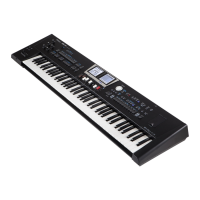127
24. Menu options
The BK-9’s [MENU] button provides access to the available
parameters and functions.
General procedure
1. Press the [MENU] button (its indicator lights).
The display changes to:
Right Display
2. Use the dial to select the desired function group.
The following function groups are available:
Function group Explanation
External Lyrics
Allows you to cancel (“O”) or activate (“On”) the display
of song lyrics on an external screen.
Performance Edit
This function group allows you to select dierent
Tones and eects settings for the keyboard parts, the
selected rhythm, to set the Arranger’s behavior, the
split point, etc. All settings of this group can be saved
to a Performance memory. See “‘Performance Edit’
parameters” (p. 127).
Global
This function group contains parameters that apply
to all sections of the BK-9. See “‘Global’ parameters” (p.
142).
Audio Key
This function lets you assign an audio le to 7 right most
keys of BK-9’s keyboard, and play those audio les by
pressing the corresponding keys. For more details see
“16. Using Audio Phrases (Audio Key)” (p. 65).
One Touch Edit
This functions allows you to edit the
ONE TOUCH memories (and to save your changes). See
“Programming Your Own ONE TOUCH Settings (One
Touch Edit)” (p. 42).
Chord Loop
This page contains parameters for the Chord Loop
function (p. 148).
Rhythm
Composer
This function group allows you to create new rhythms or
to edit existing ones (p. 103).
16Track
Sequencer
Your BK-9 contains a powerful sequencer with a host
of edit functions. Even so, you will quickly notice that
the “16 track Sequencer” is as simple to operate as it is
powerful (p. 81).
Mastering Tools
These functions allow you to set the compressor and
equalizer for Rhythm/Song and Tone separately (p.
149)
MIDI
This function group allows you to edit the BK-9’s MIDI
parameters (p. 151).
Wireless
By inserting the wireless USB Adapter (WNA1100-RL;
sold separately) into the BK-9’s USB MEMORY port,
you’ll be able to use wireless compatible applications
(p. 162).
Factory Reset
This command allows you to load the BK-9’s factory
settings (p. 159).
Format USB
Device
This command allows you to format an optional USB
memory (p. 159).
3. Push the dial to go to the display page where you can edit
the parameters of the selected group, or to execute the
selected command.
External Lyrics
This is, in fact, a switch that allows you to cancel (“O”) or activate (“On”)
the display of song lyrics on an external screen.
‘Performance Edit’ parameters
The following parameters can be set for each Performance memory:
Function group Explanation
Tone Part View
This is where you can edit settings related to Tones
(p. 127).
Tone Part Eects
Contains the eects parameters for the keyboard
parts (LWR, UPP) (p. 131).
Organ Commons
This settings allow you to specify some organ
(Harmonic Bars) parameters (p. 134).
Split
This parameter allows you to change the split point,
i.e. the separation between the lower and upper
keyboard zones. (p. 136).
Key
Allows you to transpose the BK-9 in semi-tone steps
up or down (p. 136).
Rhythm Parts
This group contains all parameters of the rhythm
parts (p. 137).
Arranger Setting
This function group allows you to specify where
and how the selected rhythm should scan the note
messages generated by your playing for chord
information (p. 137).
Dynamic Arranger
The DYNAMIC ARRANGER function allows you to
control the volume and timbre of the Arranger
parts via the way you strike the keys in the chord
recognition area (velocity sensitivity) (p.139).
Assign Switches
In this page you can assign functions to the Assign
Switches [S1], [S2], [S3], [S4] (p. 53).
Scale Tune Switch
This parameter allows you to specify which parts
should be aected by the “Scale Tune” setting “Scale
Tune Switch” (p. 140).
Scale Tune
Use these parameter to change the tuning system
(p. 140).
Melody Intelligent
Allows you to set the “Melody Intelligent” function (p.
141). This page can also be selected by pressing and
holding the [MELODY INTELL] button.
D Beam
Here you can access the D-Beam functions. This
function can be reached by pressing and holding
one of the D-BEAM buttons. See “Using the D-BEAM
Controller” (p. 53).
MIDI Set Link
This parameter allows you to link a User MIDI Set to
the Performance memory.
See “MIDI Set Link” (p. 142).
Save As Default
This function allows you to save all “Performance Edit”
settings as the new defaults that will be loaded each
time you switch on the BK-9 (p. 142).
‘Tone Part View’ parameters
This function group can be selected using [MENU] button“Performance
Edit” “Tone Part View”.
Right Display

